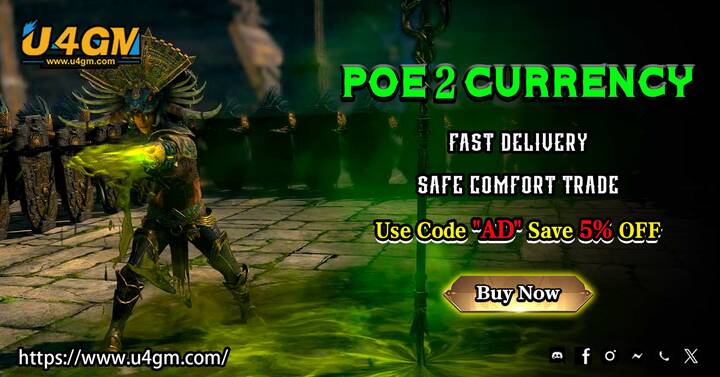الفئات
العلامات
الأرشيف
poe 2 currency sale and the Rise of Ethical Monetization in Fre
-

As the free-to-play model has become the dominant force in the gaming industry, players have grown increasingly wary of predatory monetization tactics. From aggressive loot boxes to pay-to-win systems, many titles have chosen short-term profits over long-term player trust. Path of Exile 2, the upcoming sequel to one of the most beloved ARPGs of all time, is stepping into this landscape with a refreshing and commendable stance: ethical monetization that respects both the player’s wallet and experience.
While Path of Exile 1 set a gold standard for fair monetization in a free-to-play game, its sequel is not content to simply copy the model—it seeks to refine it. In a gaming world where microtransactions often dominate the conversation, PoE 2 may become a case study in how to do it right.
No Pay-to-Win, No Shortcuts
Grinding Gear Games, the studio behind Path of Exile 2, has been very clear about one thing: their game will remain completely free-to-play without pay-to-win mechanics. This is a crucial point of differentiation from many of its competitors. Players cannot buy power. There are no paid boosts, stat enhancements, or exclusive gear that would give paying players an edge over those playing for free.
This core philosophy ensures a level playing field. Your success in PoE 2 is tied to your understanding of game mechanics, your build crafting skills, and your performance in combat—not your willingness to open your wallet.
It’s a design choice that reinforces the value of player skill and time investment, creating a healthier and more satisfying competitive environment. Whether you're clearing the campaign or diving into endgame maps, everyone plays by the same rules.
Cosmetic-Only Microtransactions
Instead of monetizing player power, buy poe 2 currency focuses its revenue on cosmetics. Armor sets, weapon effects, footprints, pets, and other visual enhancements are the heart of the game’s microtransaction system. These items have no impact on gameplay, and they serve as a way for players to express their personal style or show off their achievements.
This strategy not only avoids the pitfalls of pay-to-win but also allows for a vibrant visual ecosystem where players can support the game and still feel good about their purchase. Every flashy piece of gear is a statement, not a stat boost.
The sheer quality and variety of cosmetic options available also elevate the experience. These aren’t simple palette swaps—they’re high-fidelity, thematic additions that often tie into expansions or special events. Some players even find as much joy in customizing their characters’ look as they do in optimizing their builds.
The Stash Tab Model: Utility, Not Power
PoE 1 introduced the concept of stash tabs as a paid utility—giving players additional storage space for their growing hoards of loot and crafting materials. While some feared this might lean toward pay-to-win territory, it was implemented with a balanced hand.
In PoE 2, this model continues, but with tweaks and improvements based on years of community feedback. Players can buy specialized stash tabs for maps, currency, fragments, and other items, helping streamline their inventory management. However, these tabs are convenience-oriented rather than power-enhancing. You’re not stronger because you bought a currency tab—you’re just more organized.
This approach lets players tailor their quality-of-life experience without forcing them into purchases. It’s a rare example of a utility-based monetization system that doesn’t punish non-paying users, but rather rewards supporters without breaking the ecosystem.
Regular League Content Without a Paywall
Another standout element of poe 2 currency's business model is how it handles expansions and league content. Every few months, the game introduces a new challenge league with fresh mechanics, items, and story content—all completely free to every player.
Unlike many games that lock new content behind season passes or DLC fees, PoE 2 sticks to its philosophy: everyone should have access to the full gameplay experience. Monetization is decoupled from the core loop, allowing players to engage fully with each new league, test new builds, and explore new systems without any gatekeeping.
This fosters a vibrant and inclusive community where players of all backgrounds and budgets can engage with the game at the same time. It's a key reason why PoE continues to thrive so many years after launch—and why its sequel is poised to do the same.
Supporting Developers Without Sacrifice
Perhaps the most remarkable aspect of Path of Exile 2’s monetization strategy is that it proves a simple but often overlooked truth: players are willing to spend money if they feel respected. By avoiding manipulative tactics and instead offering optional, high-quality cosmetics and useful conveniences, Grinding Gear Games has built a loyal fanbase that consistently supports the game financially.
Founder's Packs, which will likely return for PoE 2, also give players the option to show support early on while receiving exclusive cosmetics and currency. But again, none of these perks offer gameplay advantages—they’re badges of honor, not weapons of war.
In an industry increasingly driven by monetization metrics, Path of Exile 2 offers a shining example of how to do it right. With a business model built on transparency, fairness, and respect for the player, it promises a gaming experience that doesn’t sacrifice integrity for income.
As the ARPG space continues to evolve, and as players grow more discerning about how they spend both their time and money, cheap poe 2 currency may well lead the charge toward a more ethical and sustainable future in free-to-play gaming. In Wraeclast, your power is earned—not bought—and that’s exactly how it should be.
Buy POE 2 currency at U4GM for fast and secure transactions, offering affordable prices and instant delivery to boost your gaming experience.
Recommended Article :Path of Exile 2: Top Early Skill Gems for Dominant Witch Builds